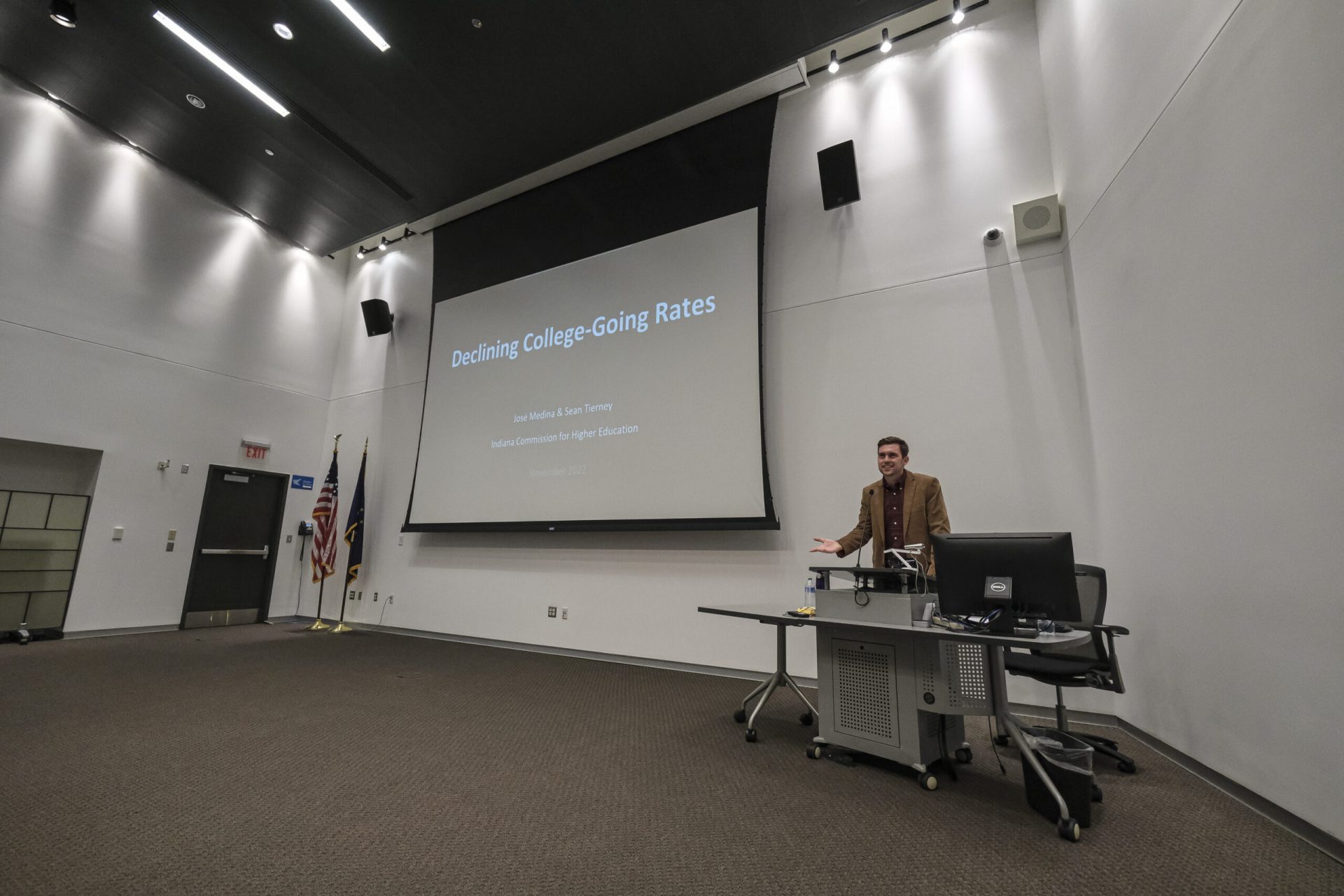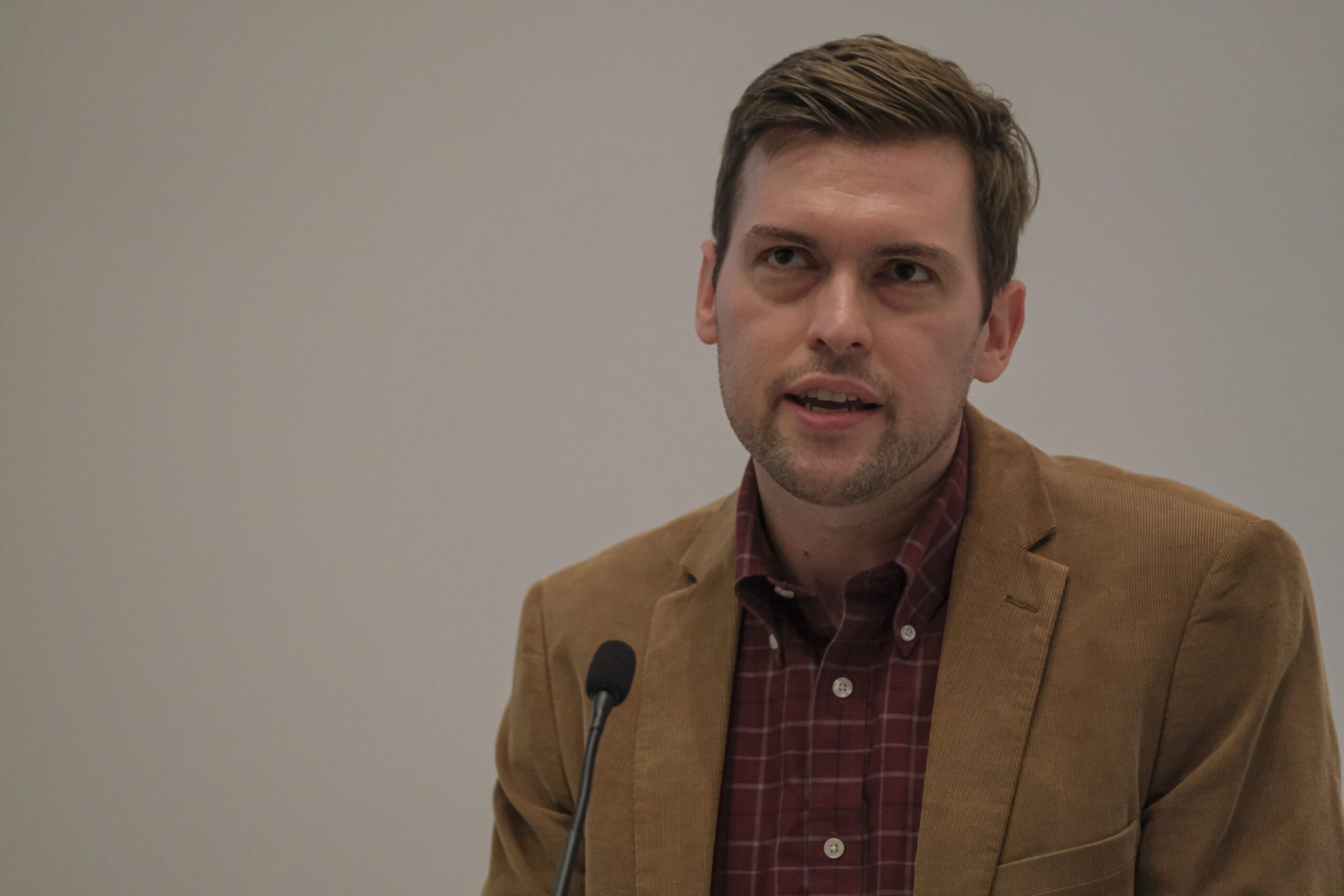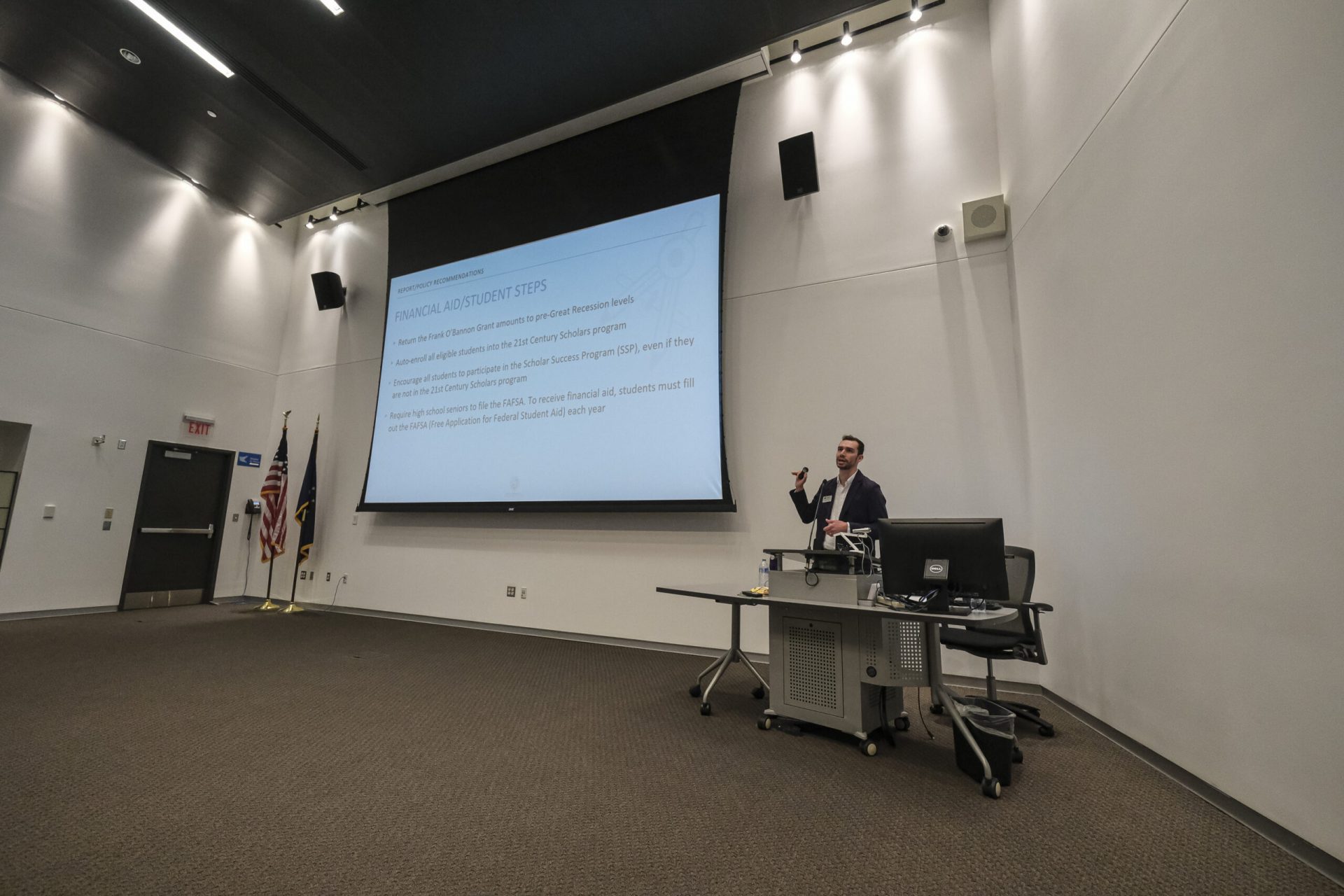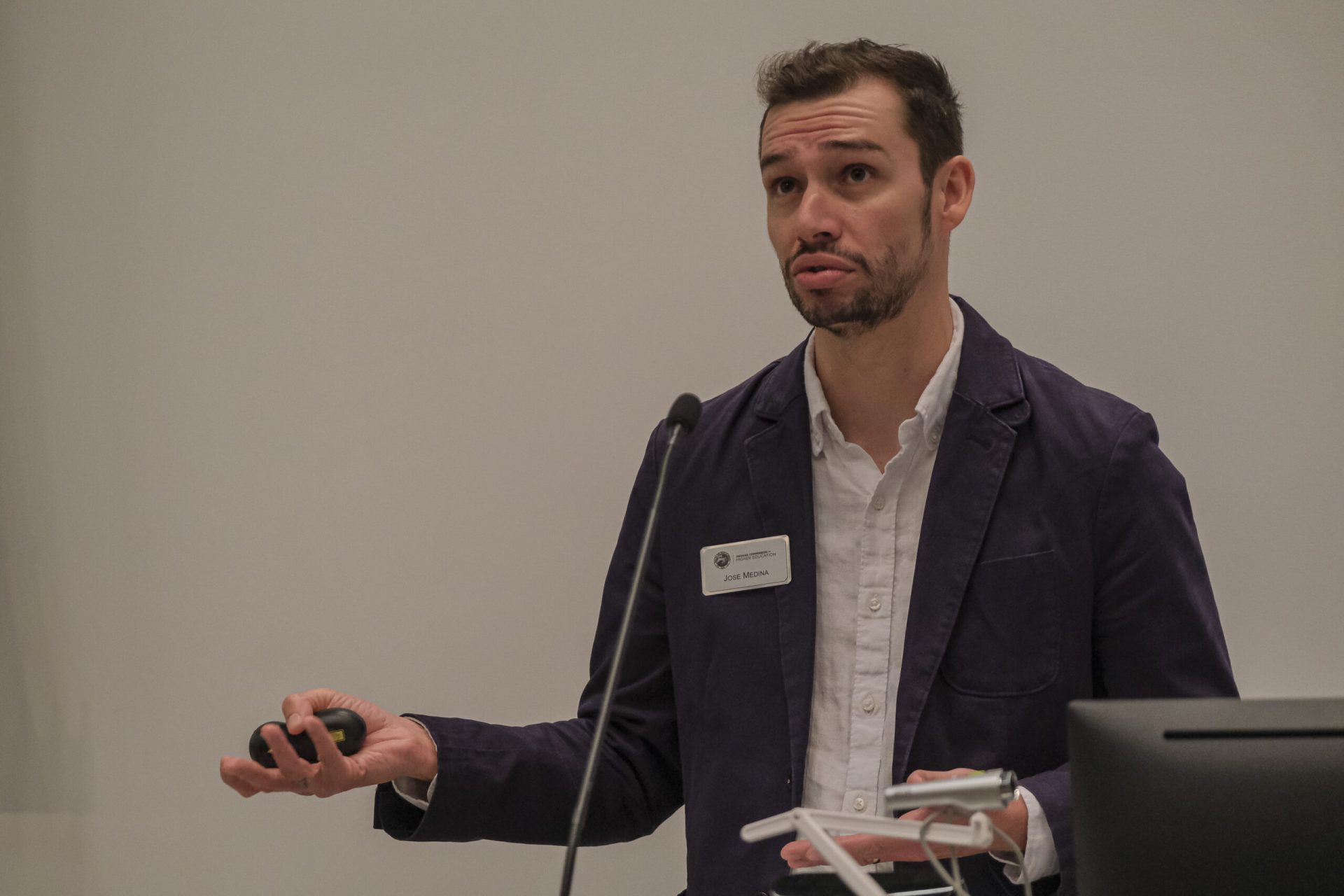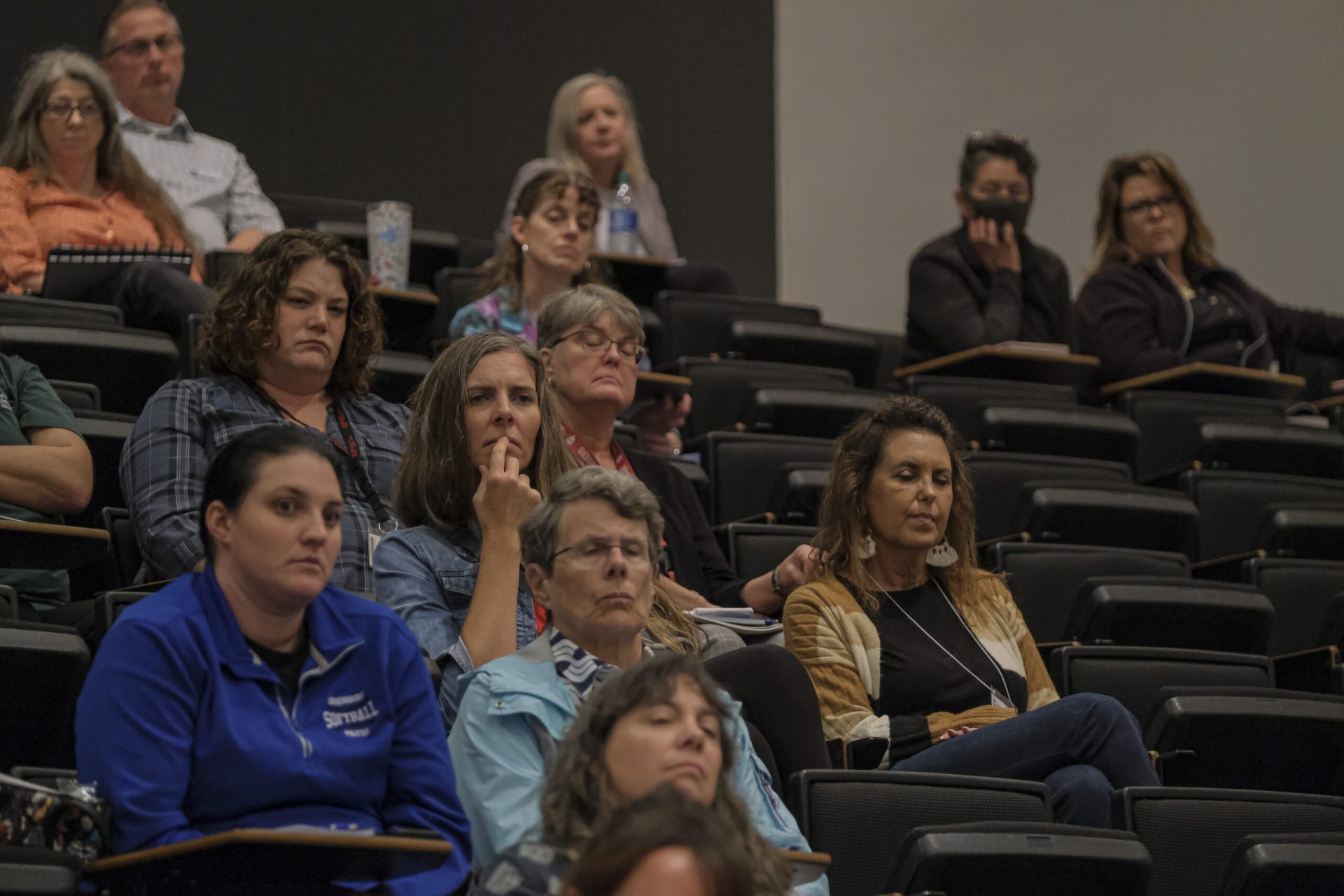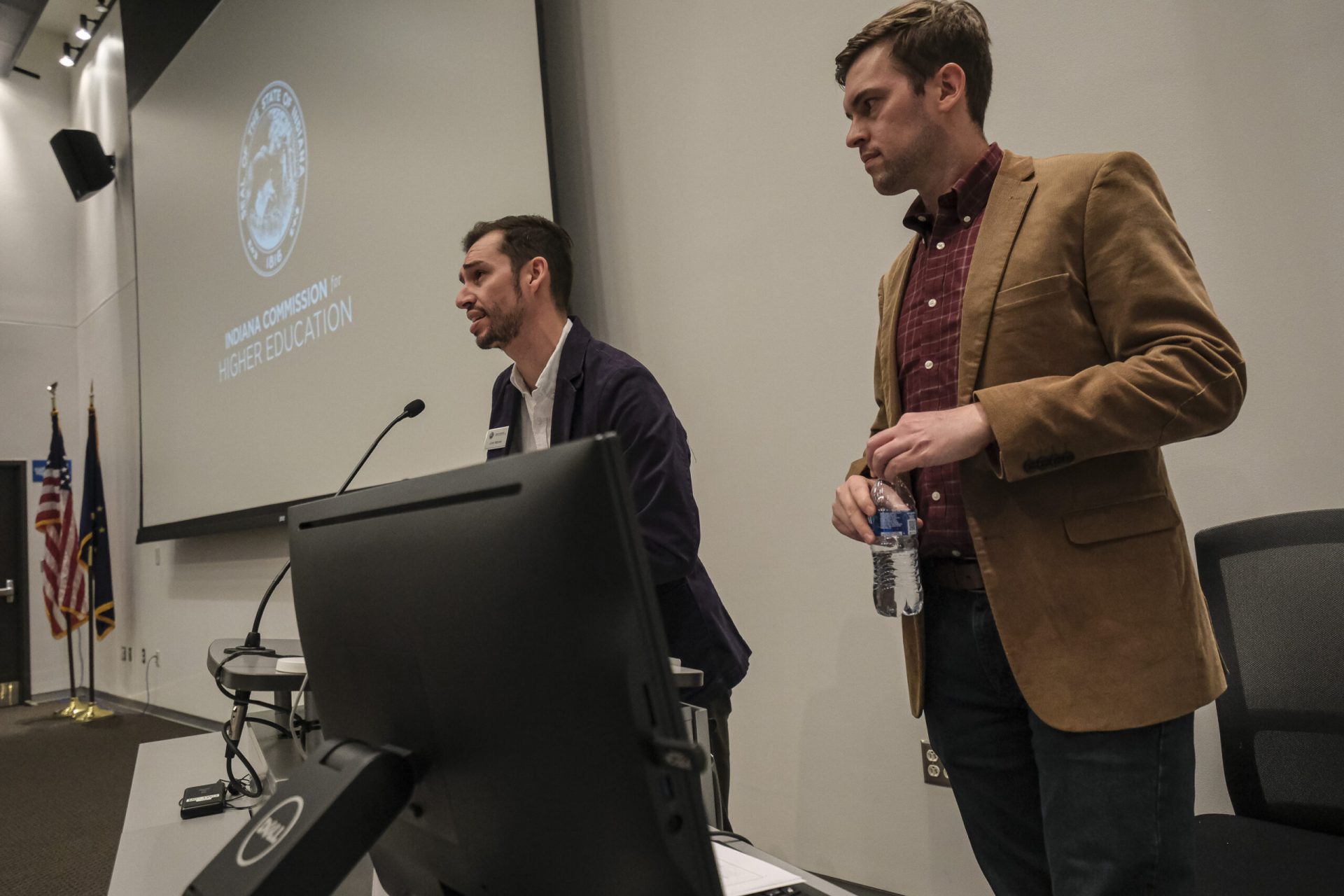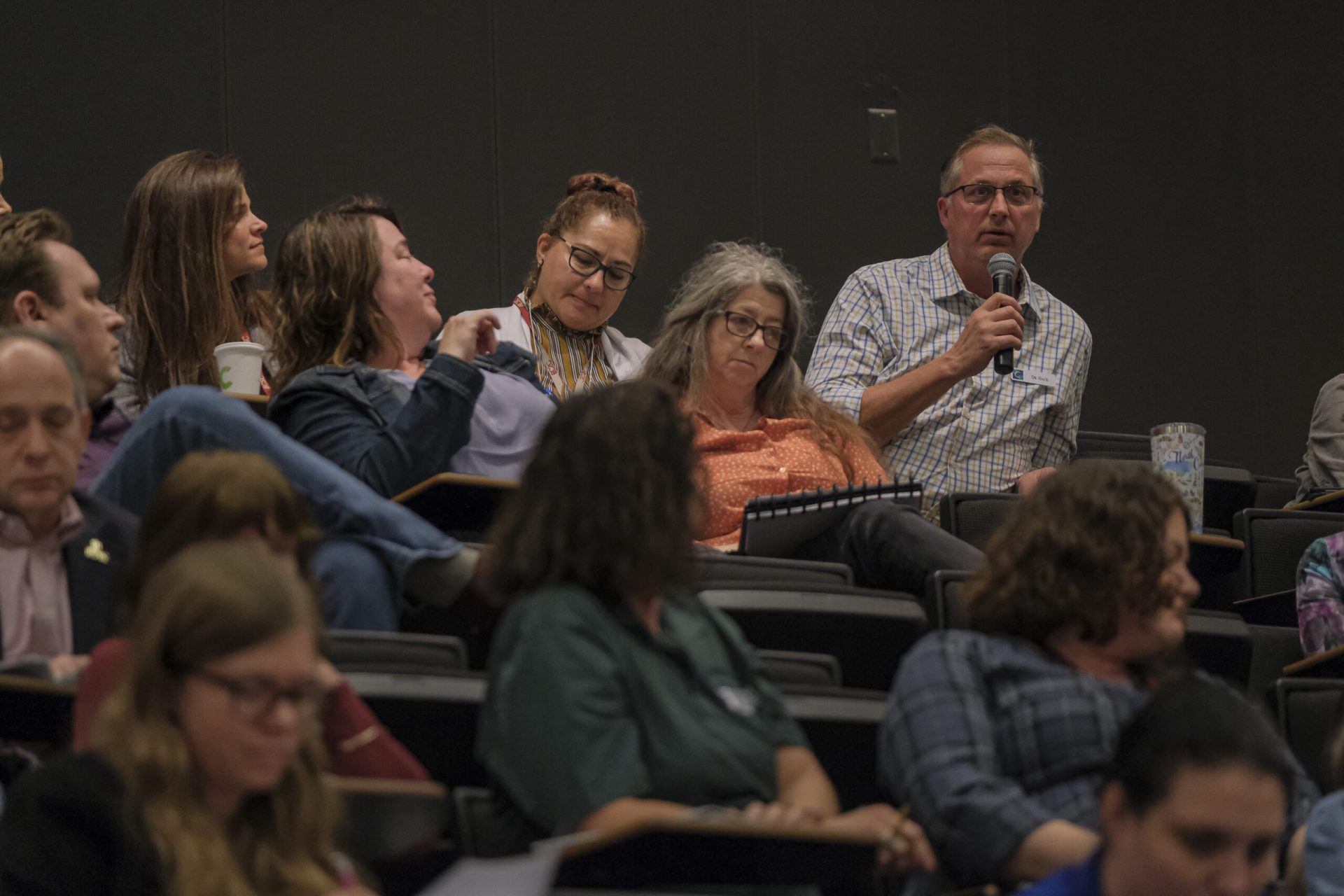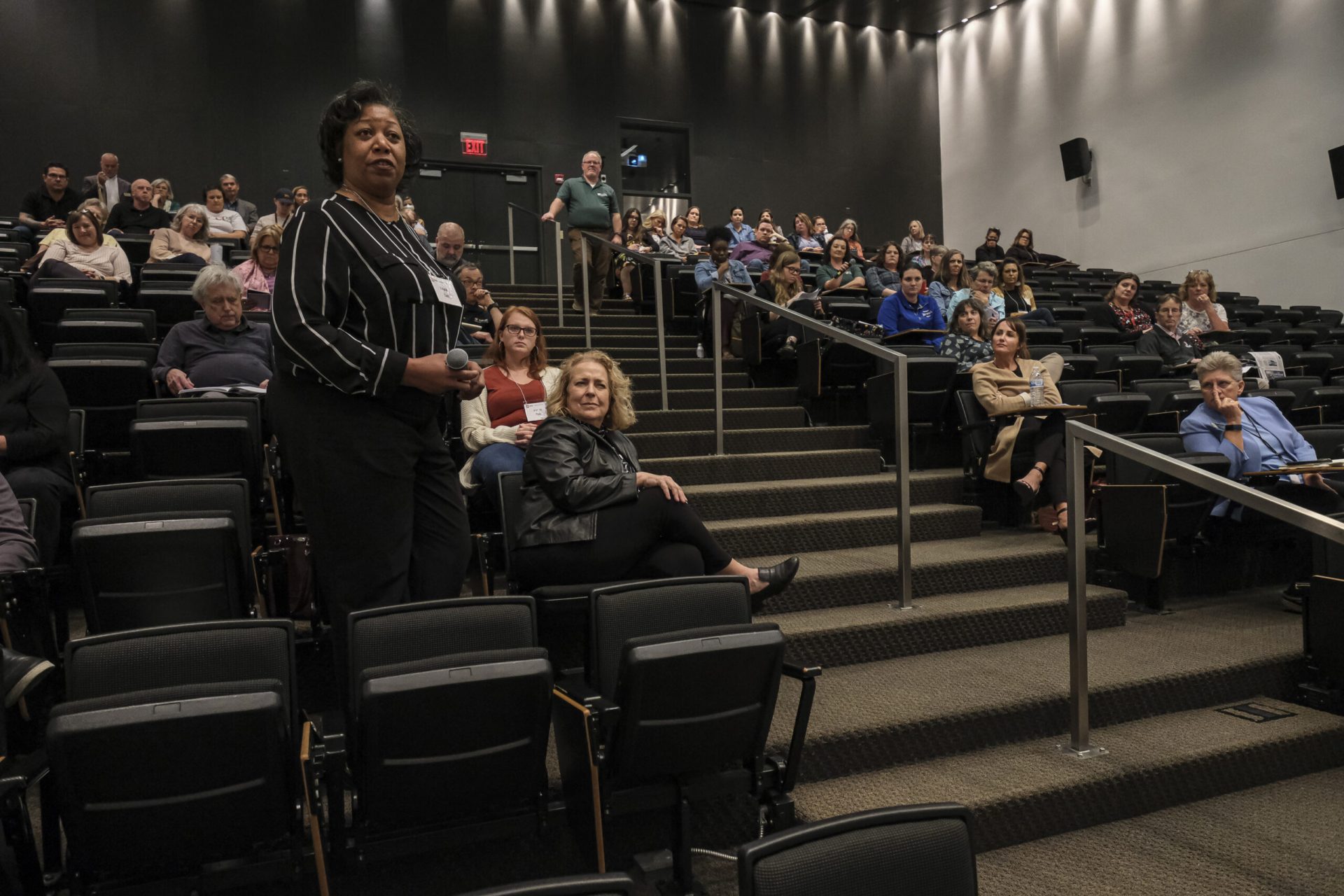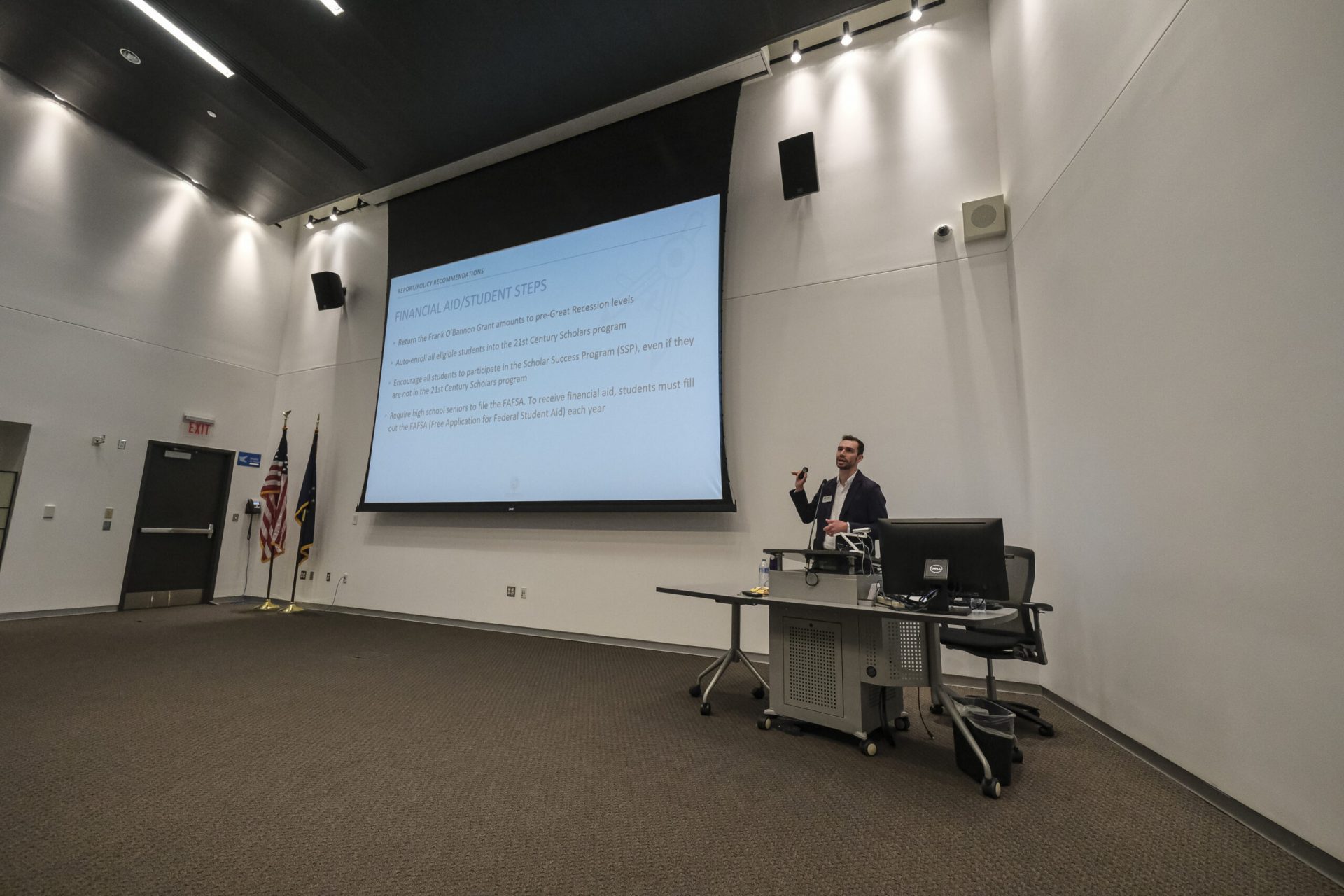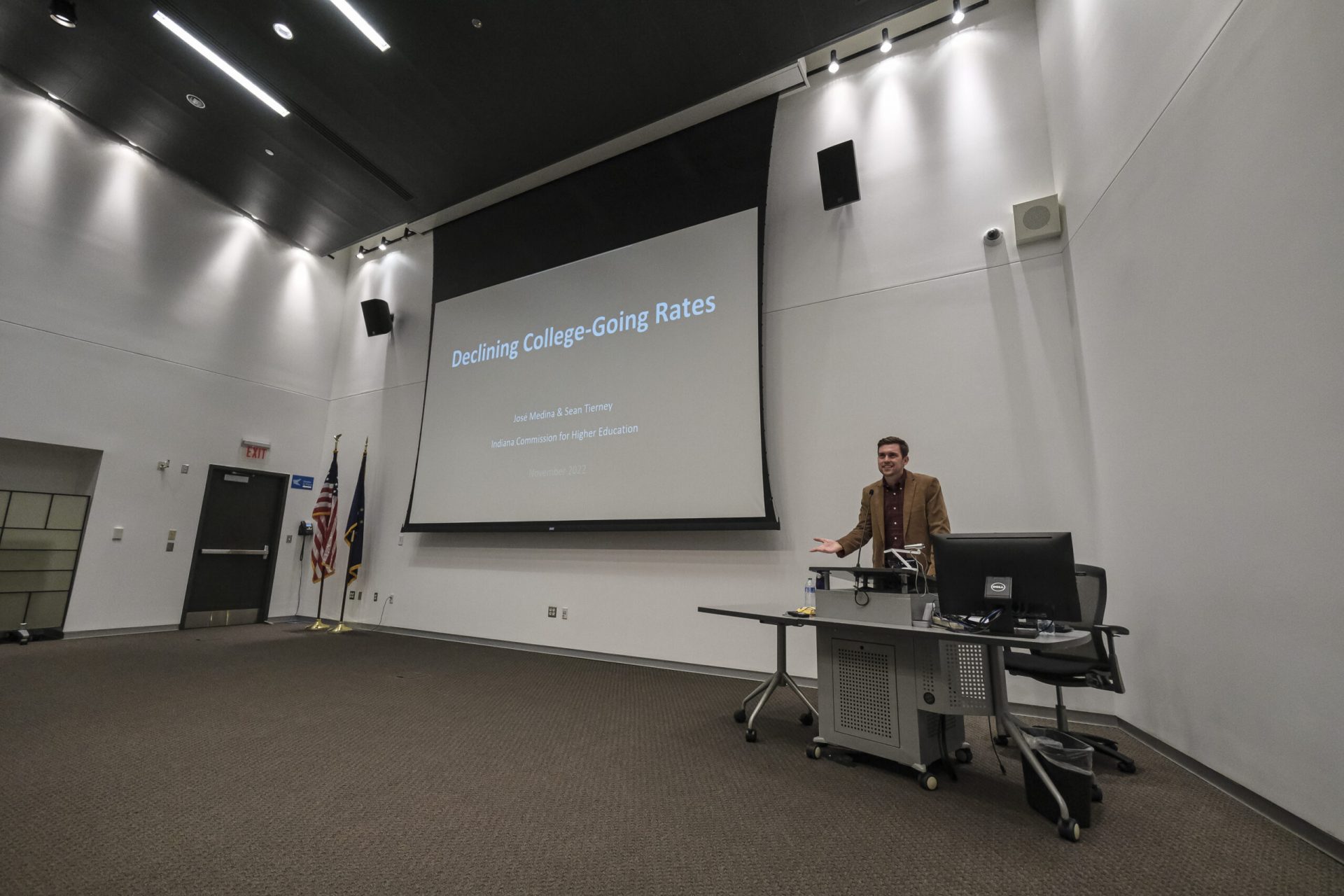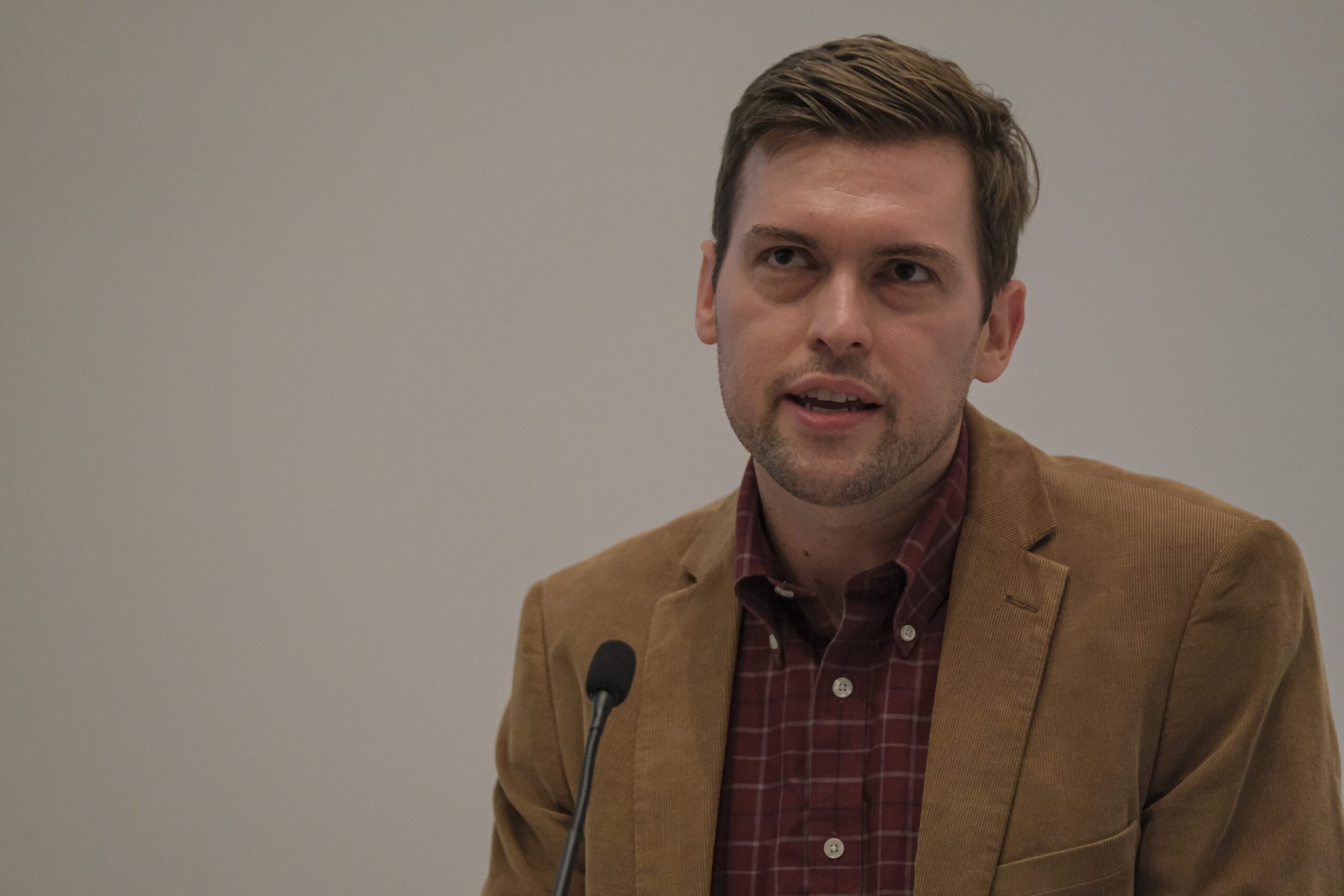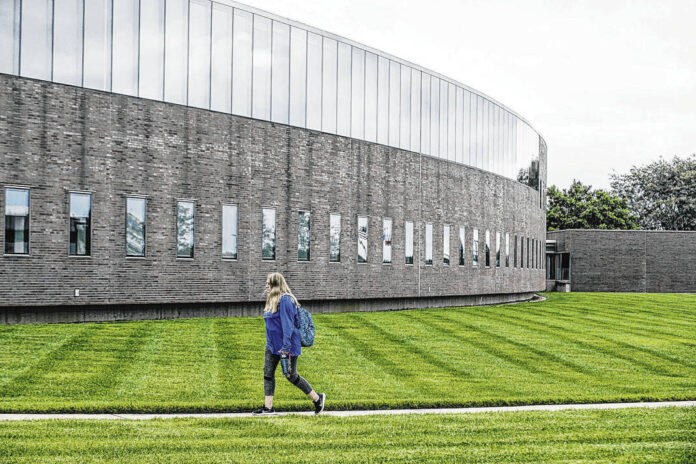
Indiana University-Purdue University Columbus student Abby Sallee walks past the Columbus Learning Center on her way to class in Columbus, Ind., Wednesday, Oct. 10, 2018. The learning center is shared by IUPUC and Ivy Tech.
Just over half of Hoosiers who graduated high school in 2020 chose to attend college the following year — a figure that has dropped significantly from 2015, when about two-thirds of graduates enrolled.
These statistics were among those shared by Sean Tierney and José Medina from the Indiana Commission for Higher Education (CHE) during a recent presentation at the Columbus Learning Center, hosted by IUPUC. They discussed enrollment trends across the state and what can be done to increase educational attainment rates.
Tierney, who directs the commission’s policy, research and data efforts, started by presenting short- and long-term trends.
In 2020, 53% of Indiana’s high school graduates went to college the following year, he said. This is down 12 percentage points from 2015. At the national level, 62.7% of high school graduates attended college in 2020, which is down six percentage points.
Interestingly, Indiana’s graduate headcounts went up almost 9 percentage points in that same time period. For both Indiana’s graduate and undergraduate students, resident enrollment has fallen over the past five years, but non-resident numbers have increased.
Tierney added that Indiana’s college-going rates show some “pretty troubling statistics” when sorted by race, ethnicity and geography. For instance, he said that students from rural areas tend to have college-going rates that are about 5 percentage points less than the statewide average.
In terms of race, the commission’s 2022 College Readiness Report stated that Indiana’s Black students showed the highest decline in college-going rates since the start of the pandemic, dropping from 50% in 2019 to 43% in 2020. Hispanic and Latino students dropped from 49% to 44%.
Parental income is a “strong indicator” of whether a student will go to college and complete their degree, Tierney said. Per the readiness report, less than 40% of Hoosier youth who qualify for free and reduced lunch go straight to college, whereas over 61% of Hoosiers with family incomes above that threshold go straight to college.
Additionally, college-going rates differ significantly by gender, with 61% of Indiana’s female high school graduates enrolling in college in 2020, versus only 46% of male graduates. At a national level, the rates are 66% of women and 59% of men.
“There’s a pretty significant and in some ways widening gender gap,” said Tierney. “Women are more likely to go to college than men. And then when we look at the racial breakdown, basically we as a state have really failed to move the needle on correcting for structural racism in the education system. And it really comes out to bear when we start looking at those college-going rates.”
Following Tierney’s presentation on the data, Medina, who is the commission’s school and community outreach manager, discussed the CHE’s recommendations on how to improve educational attainment. These included involving different sectors in the effort, continuing targeted outreach to specific groups, increasing financial aid and improving student engagement with helpful resources.
For instance, the commission is recommending that all students who are eligible to participate in the state’s 21st Century Scholars Program should be automatically enrolled. The program provides up to 100% of tuition at public colleges in-state and partial tuition at private colleges, according to Learn More Indiana.
Students, who qualify based on their family’s income, must sign up in the seventh or eighth grade and meet certain requirements to maintain their scholarship. These include earning a cumulative high school GPA of 2.5 on a 4.0 scale, graduating with at least a Core 40 diploma and completing the Scholar Success Program (which is made up of activities to keep students “on track for college and career success” during high school and college).
According to the CHE’s data, while only 53% of the state’s high school graduates moved on to college in 2020, the percentage was much higher for 21st Century Scholars, with 81% of these students going on to college.
However, less than 50% of eligible students are applying for the program, said Medina.
The commission also recommends that all students, regardless of whether or not they participate in the 21st Century Scholars Program, should be encouraged to participate in the Scholar Success Program.
It’s also recommended that the state should require high school seniors to file the Free Application for Federal Student Aid (FAFSA) or opt out, and should return Frank O’Bannon Grant amounts to “pre-Great Recession levels.” The state recently announced its intention to do the latter.
The Indiana State Budget Committee recently reviewed the request to increase the grant’s maximum base-award amounts by 35%. Under the approved increase, the maximum award is $12,400 for a student attending a private institution and $6,200 for a student at a public institution. The new amounts will go into effect during the 2023-24 year.
“This is the largest funding increase in award history, and when combined with the Federal Pell Grant, will allow thousands of Hoosier students to have their tuition and fees completely covered by financial aid,” said commission officials.
The Frank O’Bannon Grant is Indiana’s primary need-based financial aid program and annually helps about 40,000 Hoosiers afford college. Students do not need to apply for the grant but must have a current FAFSA on file to qualify.
Following Tierney and Medina’s presentations, there was a question and and answer period. During that time, one attendee noted that some of Indiana’s major recruiters, such as Salesforce, Eli Lilly and Cummins, Inc have “brought to light politics in the state as being a direct decrease for talent development coming to the state.”
While the individual did not mention any specific political issues, both Eli Lilly and Cummins have expressed opposition to the state’s near-total abortion ban — which is not being enforced at present due to an order from the Indiana Supreme Court — and have said it would affect their ability to attract and retain employees.
The audience member asked Tierney and Medina what aspects of Indiana’s political system might be “driving students either into the classroom and/or when they come out of the classroom, out of the state.”
Tierney replied that as a government employee, he would have to be somewhat careful in his response. He then went on to say that young adults in Indiana have many options for where they choose to live.
“And we’re trying to figure out how to convince them to stay, and we’re already working at a disadvantage, right?” he said. “We’re working with a state for, whatever pros that we have, we don’t have mountains, we don’t have beaches — I know, Indiana Dunes, but we don’t have an ocean. We’ve got some cities, if students are looking for cities, but nothing on the scale of the East Coast or West Coast or Chicago. We don’t have best weather either. So anytime we shoot ourselves in the foot, it’s even costlier.”
Medina added that it’s helpful for the state when employers voice their concerns and also their commendations.
Throughout their presentations, both men also emphasized the need for better communication when it comes to informing students about the different post-secondary opportunities available to them and convincing them of the value of pursuing further education.
“We do suspect that we are struggling to really push the message on the value of college,” said Tierney. “I’m sure all of you know, for decades we’ve been talking about the rising costs of tuition and fees. And we’ve really struggled, both as a state and as institutions, to really find successful ways to push back on that narrative, whether right or wrong, that college is not worth it. And we’re starting to see the results of that loss in the messaging battle.”
Medina added that when it comes to messaging, federal and state government are “the least trusted people to talk about higher education,” so it’s essential to involve “trusted messengers” in that communication, such as family, friends, community organizations and counselors.
The commission also the emphasized the importance of all post-secondary options.
“There’s a misconception because we’re the Commission for Higher Education we only care about bachelor’s (degrees), said Tierney. “And we are forever fighting back against that notion. We care about any sort of quality credential that you can earn. We tend to focus on credit-bearing credentials — bachelor’s, associate’s and credit-bearing certificates — but we’re in favor of basically anything that can provide you a steadier and better lifestyle, from an economic or a quality of life standpoint.”

